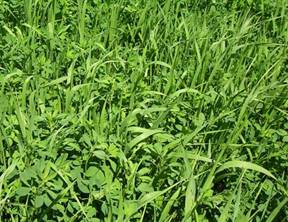Competency Area 6: Nutrient Management and Planning
PO 45. Determine crop nutrient needs by using:
- Yield potential
- Crop rotation/sequence
- Soil nutrient supply
- Soil test information
- Field history
- Pre-sidedress N test
Crop yield potential reflects the nutrient requirement of the crop. For some nutrients, particularly N, an attempt is made to match fertilizer applications with nutrient uptake patters throughout the season to optimize yield. For other nutrients, the amount of nutrient removed in the harvested portion of the crop is replaced by fertilizer (maintenance). Soil nutrient supply of P, K, Mg, etc is evaluated using a soil test. Refer to earlier competency areas for details on testing and evaluating crop nutrient needs.
Crops in a crop rotation impact the nutrient needs in two major ways. First, fertilization of one crop may also provide sufficient fertility for others in the rotation. Basically, crop nutrient needs can be provided for the rotation, rather than the individual crops. Second, the portion of a crop returned to the soil can increase or decrease the need for a nutrient by the succeeding crop. Nitrogen fertility is one example: if a crop follows a legume (low C:N ratio in the residue), N fertilizer needs are often reduced. If a crop follows a small grain (high C:N ratio in the residue), N fertilizer needs are often increased.
Soil test information provides an estimate of the productivity of a soil. Nutrient needs in more productive soils are often greater than those in less productive soils, as more nutrients will be withdrawn from a more productive soil.
Field history, such as the sod, manure, and fertilizer background, also influence nutrient levels. Nitrogen from sods becomes available through mineralization and nitrification. N availability from crop residues varies depending on sod composition and year since plowdown. For example, in NY, the following credits from sods are applied to corn following sod:
To calculate the total amount, multiply the decay series value by the estimated total N pool in the sod: |
 <40% legume pasture (image source) |
N recommendations in the Northeast are not based on a soil nitrate (NO3-) test, as nitrate is very mobile in the soil and is subject to leaching. Crop needs are usually derived from information about the yield potential of a field (ideally based on historic yield data), its place in the crop rotation, estimated soil N supply from mineralization of organic matter, and management history of the field, especially when manure has been applied in previous years. The final recommendation needs to be adjusted for N fertilizer uptake efficiency, recognizing that not all N applied will end up in the crop.
For instance, here is a calculation for N requirements for corn in New York state.
- N (lbs/acre) = ([yield potential (bu/acre) x 1.2] – soil N supply – sod N supply)/N uptake efficiency
![]()
- For example: third-year corn after alfalfa; no manure in previous three years. Tiled and drained lima soil; yield potential = 140 bu/acre; N uptake efficiency = 70%; soil N = 75 lbs/acre; sod N = 10 lbs/acre.
N = ([140 x 1.2] – 75 – 10) / 0.70 = 119 lbs/acre
Quick Links
- Competency Area 1: Basic Concepts of Plant Nutrition
- Competency Area 2: Basic Concepts of Soil Fertility
- Competency Area 3: Soil Testing and Plant Tissue Analysis
- Competency Area 4: Nutrient Sources, Analyses, Application Methods
- Competency Area 5: Soil pH and Liming
- Competency Area 6: Nutrient Management and Planning
